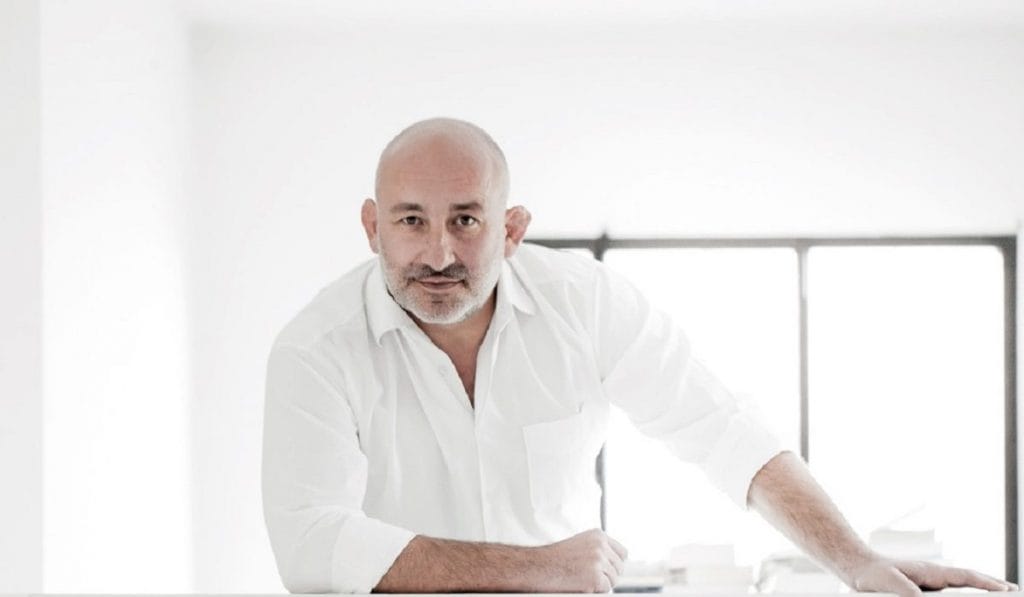French designer and architect Jean-Marie Massaud calls himself an “old millennial boy” and indeed, at the age of 51, he still has the temperament of a younger, experiment-driven generation. Trained as an engineer but drawn to the flexibility and freedom of design, he has a catholic penchant for projects that sees him leaving his mark on products as diverse as submarines, perfume bottles, cars and furniture.

Massaud is rarely seen in colours other than white, a hue he claims gives him positive vibes and calms him down.
Massaud, who was in Singapore for Space Asia’s 16th anniversary, has an eccentric mind that is at once curious, distracted and hyperactive; during our hour-long conversation, he jumps from topic to topic, taking a breather only for a sip of coffee.
His energy and creative vision have led renowned furniture brands to seek him out, giving birth to sleek, organic pieces, such as the Inout lounges and cloud-like Wallace Chair with Cappellini and Poliform respectively, that gained Massaud a following among home design pundits.
The Peak sits down with the famed designer as he spills the beans on his latest collaboration with Poliform, why his mind is like a Mentos and his wackiest design project ever.
How do you rate furniture design, against the other types you’ve done?
I suppose that the mark of a good designer is when companies approach you for your vision; and if they ask me to design a chair, I’d do it. But I don’t care for it. Big furniture companies don’t have a vision or care about legacy: they want to earn money. They don’t dare to take risks and prefer the same formula. I don’t want to work in the furniture field anymore, but I still get approached.
Then why Poliform?
This brand has a unique ability to develop high-quality products at the industrial level. Few companies have this level of quality and flexibility; they are usually very bourgeois and conservative. They like to do only certain elements, but Poliform can do many configurations. I don’t work for money these days anyway – I’m not a materialistic person. Innovation and relationships with people excite me instead, cooperating with kind and open-minded people who don’t make this just about work but about an exchange. This was the case with Poliform.

The Wallace Chair, for Poliform.
In your opinion, what are the unique aspects of your designs?
My designs aren’t that unique. It’s quiet, though I try to introduce more style. My aim is to provide quality and timelessness. I work on the frames’ and materials used in the furniture so that they will last. They aren’t very provocative, but you will appreciate the quality of these pieces with time. These pieces are expensive, so you will want to enjoy them for a long time.

The whale-shaped airship designed by Massaud is a developing idea that may soon become reality.
You’ve taken up numerous projects in your career. How do you manage that and relax?
I try to calm down, because when I get excited, I’ll want to rush the project out and do more. I would take up 15 projects at one time and force myself to spend time on each. But it’s at this point that you neglect to feed your soul, to relax and live.
According to my doctor, I need excitement because I’m hyperactive. He compared my mind to a Mentos dropped in a bottle of soda; it will erupt. I was advised to do an hour of sports and meditate before working. This holistic approach is something I need, but I’m not disciplined enough to do it. Two weeks before coming to Singapore, I was in Kerala, India, doing yoga and meditation. For the past two days, it was less sexy: I went to the gym and it felt like being a rat in a laboratory.
What’s your craziest design?
It would have to be the Manned Cloud flying hotel. In 2005, I was asked by some American developers to develop a resort at Palm Desert, California. I wanted to create a unique experience in the desert, like a tent village that changes location every couple of days. The developers thought I was crazy: They didn’t care about experience, they just wanted a hotel. But it didn’t make sense; people who go there want something different. I said that if I were so crazy, I’d do a cruise by air.
So, with my engineering background, I conceptualised an air cruise going around the world at a slow pace. I’ve been doing research with the engineers of French aerospace research lab Onera to make this a reality. It’s very exciting, and nothing has changed about the project. I wanted it to look like a white whale instead of a blimp (see inset picture) – which can be scary for people especially after the 1937 Hindenburg disaster. It’s not supposed to be stylish; I’m not going to slap green on it just because it’s trendy. It should be peaceful and light, and give the right emotions.


